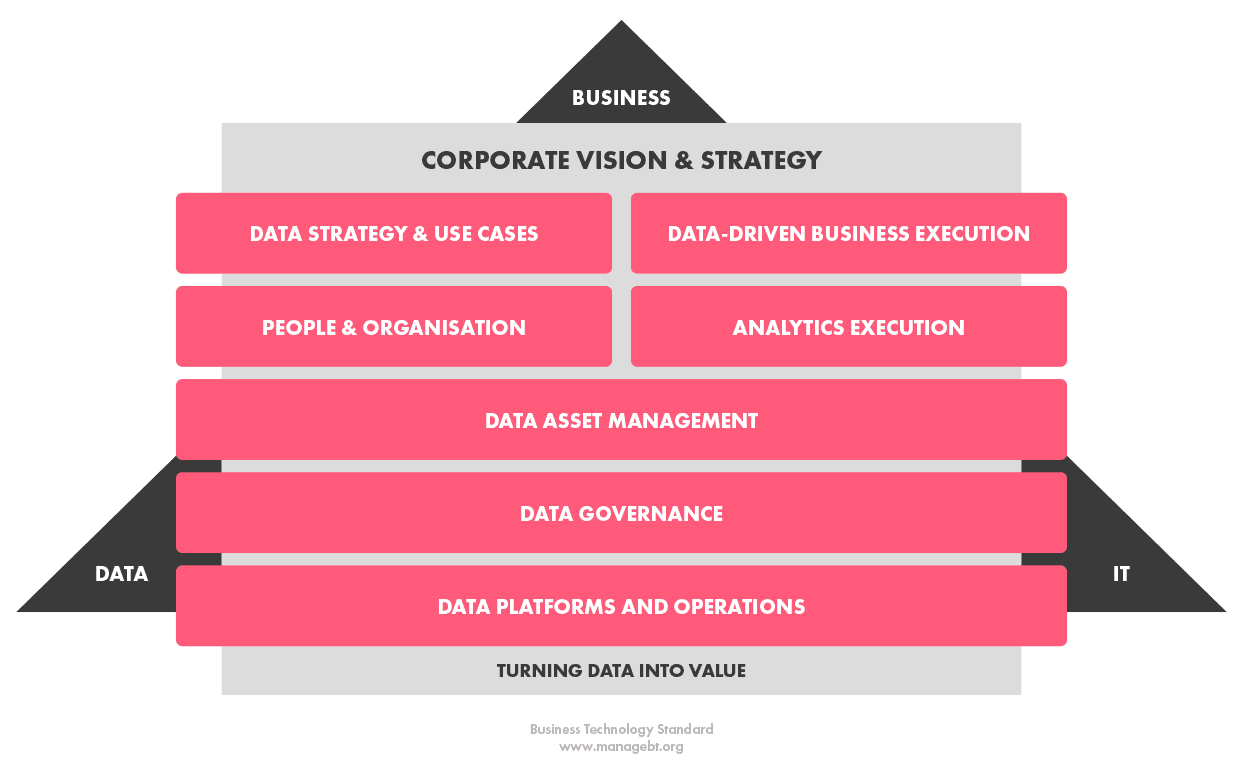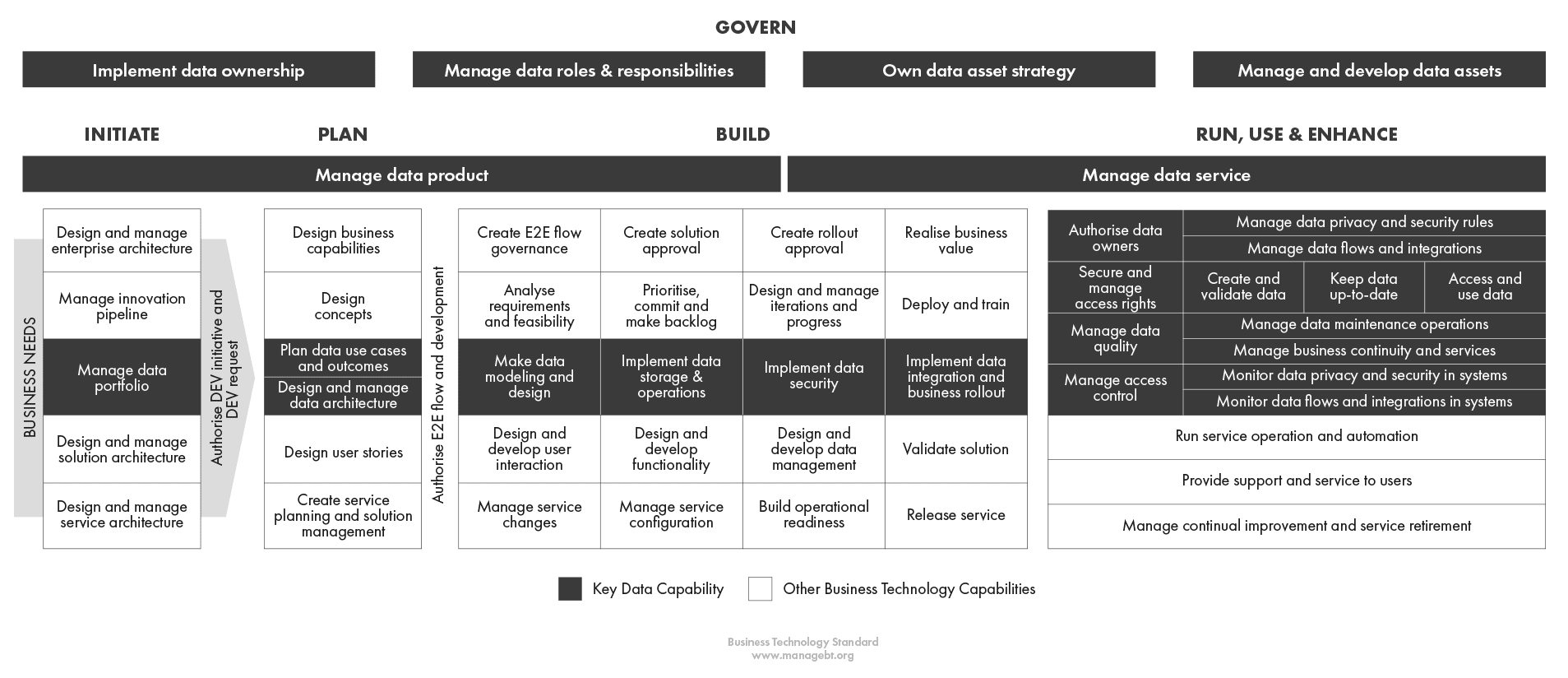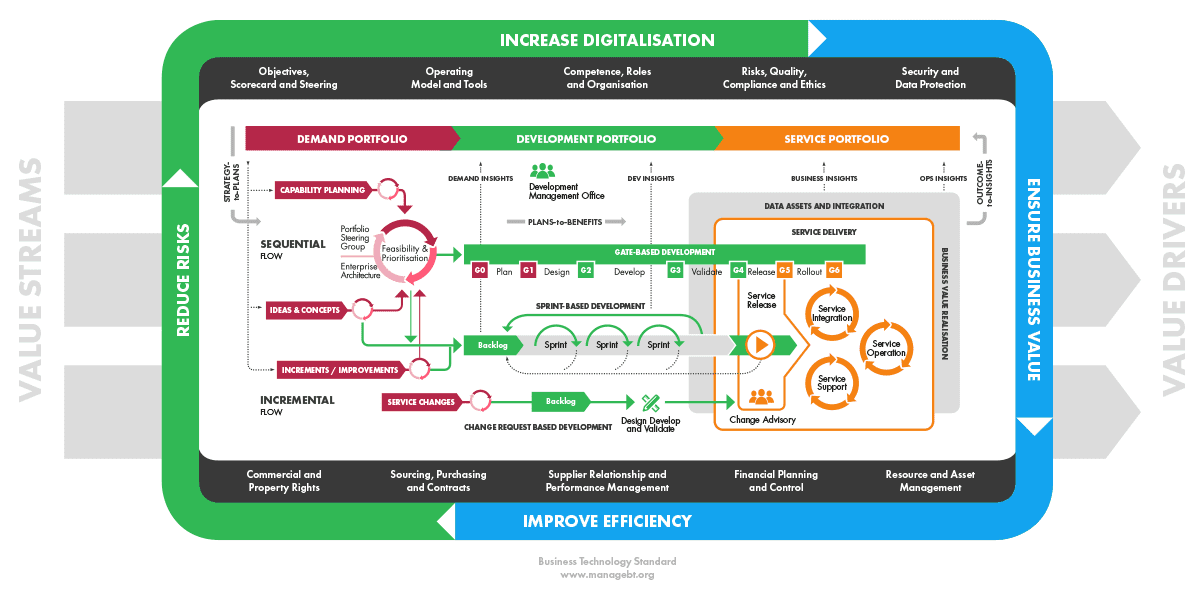Data is a strategic business asset and one of the most valuable resources a company has. But its value is dependent on quality, relevance and scope. Turning data into a high value commodity requires a journey of transformation. Indeed, as a company’s own levels of data management matures so the benefits of data grow too.
It takes a data centric vision, a value creation attitude, commitment from the management team and resources, as well as clear data ownership, roles and responsibilities.
To drive real benefits, data assets can be utilised by different businesses and functions in a number of ways either to create new revenue streams or deliver change, such as:
Figure 2.7.1 Turning data into value
To become a data-driven company and turn data into value, it’s essential to have a company-wide vision. Key success factors for leading the data transformation journey are:

Figure 2.7.2 Elements of a data-driven company
The individual elements that distinguish a data-driven company are:
Corporate strategy sets the level of ambition a company has and informs the transformation strategy needed to become a data-driven company.
However, data is only valuable for the business when it is well governed, managed and made available. The data asset management model defines the following perspectives:
These different perspectives can be illustrated as the seven facets of a diamond. When all the sides of the diamond are in excellent shape the business can realise maximum benefit.
Figure 2.7.3 Perspectives of a data asset
Data analytics, based on analysing data from different sources, provides valuable business information. Typical sources of data are varied and include business applications, data warehouses, publicly available data sources and operational data from sensors.
Figure 2.7.4 Overview of data analytics
Traditional business intelligence deals primarily with what is known as descriptive analytics. Using historical data, it provides hindsight and explains what has happened and why.
Data science addresses predictive and prescriptive analytics. It reveals insights and foresights about the future based on patterns in the data, such as what is likely to happen and which decisions and actions should be taken as a result of the intelligence.
Insights into customer behaviour can be gained by simultaneously testing two alternatives, known as A/B testing. Data is collected through experimentation with one group of customers and correlated with a different service or product. For instance, an internet store can divert one group of customers to a new version of the storefront and compare their behaviour and actions to people using the default storefront.
As such, the real-time availability of data and sensor-based IoT data can support the decision to optimise operational processes, services and assets.
Business processes span across different business solutions and data sources. Therefore, data flows, how data moves from one part of a system to another part, and data integrations, how data originating from different sources is combined, are an essential part of business technology management. Data flows play an essential role in automating data between multiple systems inside or outside the organisation. But without integration, the data remains in silos and only serves the needs of a limited group of people or functions and restricts new views, especially from a reporting and analysis point of view. So, it’s important to prioritise this.
There are several system-integration options:
The complexity of integrations varies greatly and is often underestimated because integrations usually contain other aspects than just the technical integration. For example, security, access rights and error handling requirements may cause extra work for integrations. Furthermore, the data at hand and its meaning must be understood in a consistent way by all the systems involved.
The data capability model is an action-based illustration on how a company can create business value with data. It features the Business Technology Standard operating model principles and highlights the capabilities needed for planning, building and running data products and data services. The identified capabilities are then used as the basis for defining the roles that need to be in place across the organisation.
The data capability model follows the plan-build-run structure and is aligned with the other aspects of business technology management. The dark grey elements in the illustration below are data focused and go hand-in-hand with other elements. In many cases, the same people and governance bodies make decisions on business, technology and data at the same time and is therefore an essential part of business value creation.
 Figure 2.7.5 Data capabilities
Figure 2.7.5 Data capabilities
When establishing data ownership and governance it is important to define and assign the data roles. There are eleven key data roles, which are distributed across the Business, Data and Technology side of the organisation.
Figure 2.7.6 Data roles
Head of Data – is responsible for the data-related development roadmap in the business division. Head of Data nominates Data Owners in their business domain.
Data Owner – is responsible for planning the data use cases and outcomes. Data Owners ensure the data quality.
Data Manager – knows the data content and quality standards and implements changes in processes.
Data User – influences the data asset value by using data and creating new data. Data Users ensure that data quality follows the defined rules.
BTDO / Chief Data Officer – leads the centralised data function. BTDO/Chief Data Officer leads data-related services and sets structure for the data assets.
Data Domain Lead – facilitates discussions on development initiatives and defines data quality across a data domain. A Data Domain Lead enables the data asset development across business lines.
Data Architect – defines the data design: data collection, data storage and data flows across the organisation.
Data Expert – implements data administration, data cleansing or other data services. A Data Scientist is one of the Data Experts and analyses trends and patterns that can be used as insights in business operations and management.
Service Manager – is responsible for defining, building and managing data services for the business users.
Key User – is an advanced user, who helps other users use data solutions in a smart way. Key Users initiate the development or change requests on behalf of user groups.
Service Agent – serves end users on a service desk or as a technical service expert.
Data governance provides data management guidance and control. Corporate vision and strategy provide direction for the data strategy. Data strategy sets the goals for managing data assets and introduces guiding principles on how data should be managed. The organisational setup of data governance provides the decision-making structure including forums, meetings, steering, control and escalation paths. Clear roles and ownership define accountability and responsibilities. Policies state processes to be followed, establish standards and enable control.
Figure 2.7.7 Data governance and decision making
The Data function led by the Chief Data Officer helps businesses to manage and increase the value of the data by organising data design, development, controls, governance and operations in a professional and cost-efficient manner.
A centrally managed data function ensures a harmonised way of working, data consistency and the required professional competencies. Depending on the structure and culture of an organisation, a replicated or federated model may be suitable as well.
